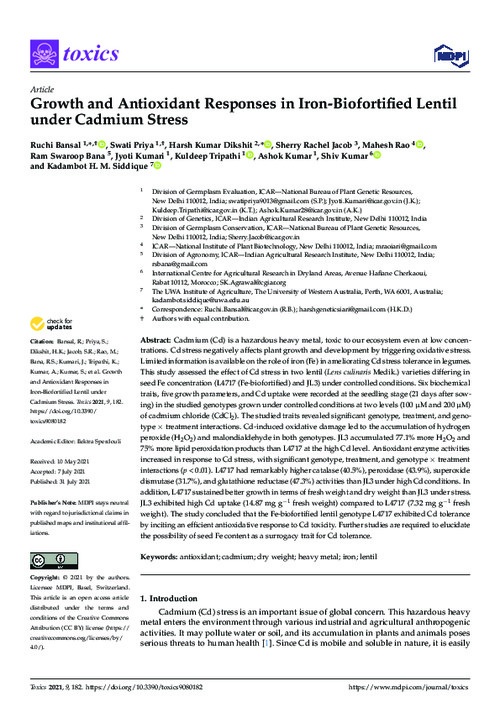Growth and Antioxidant Responses in Iron-Biofortified Lentil under Cadmium Stress
Abstract
Cadmium (Cd) is a hazardous heavy metal, toxic to our ecosystem even at low concentrations.
Cd stress negatively affects plant growth and development by triggering oxidative stress.
Limited information is available on the role of iron (Fe) in ameliorating Cd stress tolerance in legumes.
This study assessed the effect of Cd stress in two lentil (Lens culinaris Medik.) varieties differing in
seed Fe concentration (L4717 (Fe-biofortified) and JL3) under controlled conditions. Six biochemical
traits, five growth parameters, and Cd uptake were recorded at the seedling stage (21 days after sowing)
in the studied genotypes grown under controlled conditions at two levels (100 M and 200 M)
of cadmium chloride (CdCl2). The studied traits revealed significant genotype, treatment, and genotype
 treatment interactions. Cd-induced oxidative damage led to the accumulation of hydrogen
peroxide (H2O2) and malondialdehyde in both genotypes. JL3 accumulated 77.1% more H2O2 and
75% more lipid peroxidation products than L4717 at the high Cd level. Antioxidant enzyme activities
increased in response to Cd stress, with significant genotype, treatment, and genotype treatment
interactions (p < 0.01). L4717 had remarkably higher catalase (40.5%), peroxidase (43.9%), superoxide
dismutase (31.7%), and glutathione reductase (47.3%) activities than JL3 under high Cd conditions. In
addition, L4717 sustained better growth in terms of fresh weight and dry weight than JL3 under stress.
JL3 exhibited high Cd uptake (14.87 mg g?1 fresh weight) compared to L4717 (7.32 mg g?1 fresh
weight). The study concluded that the Fe-biofortified lentil genotype L4717 exhibited Cd tolerance
by inciting an efficient antioxidative response to Cd toxicity. Further studies are required to elucidate
the possibility of seed Fe content as a surrogacy trait for Cd tolerance

